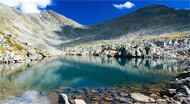Sredna gora (Unique identification code in the register: BG0001389)
Category: PZ under the Habitat Directive
Area: 110373.64 hectares Location:
1.
District: Pazardzhik, Municipality: Panagyurishte, Locality: Oborishte, Panagyurishte, Poibrene
2.
District: Pazardzhik, Municipality: Strelcha, Locality: Strelcha
3.
District: Plovdiv, Municipality: Hisarya, Locality: Hisarya, Krasnovo, Krastevich, Matenitsa, Starosel
4.
District: Plovdiv, Municipality: Karlovo, Locality: Bogdan, Karavelovo, Kliment, Klisura, Rozino, Slatina
5.
District: Sofia, Municipality: Chavdar, Locality: Chavdar
6.
District: Sofia, Municipality: Chelopech, Locality: Chelopech
7.
District: Sofia, Municipality: Elin Pelin, Locality: Golema Rakovitsa
8.
District: Sofia, Municipality: Ihtiman, Locality: Bardo, Belitza, Ihtiman, Mirovo, Muhovo
9.
District: Sofia, Municipality: Koprivshtitsa, Locality: Koprivshtitsa
10.
District: Sofia, Municipality: Kostenets, Locality: Dolna Vasilitsa, Gorna Vasilitsa
11.
District: Sofia, Municipality: Mirkovo, Locality: Kamenitsa
12.
District: Sofia, Municipality: Pirdop, Locality: Dushantsi, Pirdop
13.
District: Sofia, Municipality: Zlatitsa, Locality: Karlievo, Petrich, Zlatitsa
14.
District: Sofia, Municipality: Аnton, Locality: Аnton
Falls in the territory of the following Regional Inspectorates of Environment and Water (RIEW):
1.
Pazardzhik - ul. "Gurko" № 3 et.4 p.k.220
2.
Plovdiv - bul."Maritsa" 122
3.
Sofiia - bul."Tsar Boris III" №136
Ordinance for announcement:
Ordinance No.РД-274 from 31.03.2021
2-2-1389-274-2021
Ordinance for change:
Change in the area - increase with Decision No.811 from 16.11.2010
Record for protected zone (link):

Aims of the declaration:
1. Protection and maintenance of natural habitats types under item 2.1, habitats referred to item 2.2. species, their populations and distribution within the area to achieve and maintain their favorable conservation status in the relevant biogeographical regions;
2. Increasing the contribution of the protected area in relation to the area of ??natural habitat with code 7140 in the part of the protected area falling within the Alpine biogeographical region;
3. Improving the structure and functions of natural habitats with codes 6210 (*important orchid habitats), 62D0, 91E0*, 91M0 and 91W0 in both biogeoraphical regions;
4. Improvement of the structure and functions of natural habitat with code 6430 in the part of the protected area falling within the Alpine biogeographical region and of natural habitats with codes 91Z0 and 91G0 * in the part of the protected area falling within the Continental biogeographical region;
5. 'Improvement of habitats of species in the part of the protected area falling within the Continental biogeographical region;
6. If necessary, improvement of the condition or restoration of types of natural habitats refered in item 2.1, habitats of the species refered in item 2.2 and their populations.
7. Maintaining the connectivity of the habitats of the priority species for conservation * Brown bear (Ursus arctos) and * European wolf (Canis lupus).
Objects of protection (species or habitats):
1. Article 6, paragraph 1, section 1 from Biological Diversity Act: 5130 Juniperus communis formations on heaths or calcareous grasslands;
5210 Arborescent matorral with Juniperus spp. ;
6110 * Rupicolous calcareous or basophilic grasslands of the Alysso-Sedion albi;
6210 Semi-natural dry grasslands and scrubland facies on calcareous substrates (Festuco-Brometalia) (*important orchid habitats);
6230 * Species-rich Nardus grasslands, on siliceous substrates in mountain areas;
62A0 Eastern sub-Mediterranean dry grasslands;
62D0 Oro-Moesian acidophilous grasslands;
6430 Hydrophilous tall herb fringe communities of plains and of the montane to alpine levels;
6510 Lowland hay meadows;
6520 Mountain hay meadows;
7140 Transition mires and quaking bogs;
8210 Calcareous rocky slopes with chasmophytic vegetation;
8220 Siliceous rocky slopes with chasmophytic vegetation;
8230 Siliceous rock with pioneer vegetation of thSedo-Scleranthion or Sedo albi-Veronicion dillenii;
8310 Caves not open to the public;
9110 Luzulo-Fagetum beech forests;
9130 Asperulo-Fagetum beech forests;
9170 Galio-Carpinetum oak-hornbeam forests;
91AA * Eastern white oak woods;
91E0 * Alluvial forests withAlnus glutinosa and Fraxinus excelsior ( Alno-Pandion, Alnion incanae, Salicion albae);
91G0 * Pannonic woods withQuercus petraea and Carpinus betulus;
91M0 Pannonian-Balkanic turkey oak-sessile oak forests;
91W0 Moesian beech forests;
91Z0 Moesian silver lime woods;
2. Article 6, paragraph 1, section 2 from Biological Diversity Act: Mammals - (Ursus arctos), (Canis lupus), (Vormela peregusna), (Lutra lutra), (Spermophilus citellus), (Rhinolophus ferrumequinum), (Rhinolophus hipposideros), (Rhinolophus euryale), (Myotis myotis), (Myotis bechsteinii), (Myotis emarginatus), (Myotis blythii), (Barbastella barbastellus);
Amphibians and reptiles - (Bombina variegata), (Triturus karelinii), (Elaphe sauromates), (Emys orbicularis), (Testudo graeca), (Testudo hermanni);
Fish - (Barbus cyclolepis), (Rhodeus amarus), (Cobitis taenia);
Intervertebrates - (Austro- potamobius torrentium), (Lucanus cervus), (Cerambyx cerdo), (Morimus funereus), (Osmoderma eremita), *Алпийска розалия (Rosalia alpina), *Четириточкова меча пеперуда (Euplagia (Callimorpha) quadripunctaria), (Polyommatus eroides), (Lycaena dispar), (Coenagrion ornatum), (Cordulegaster heros);
Plants - Hamatocaulis vernicosus.
Current prohibitions and regimes:
1. It is prohibited conducting races with motor vehicles outside the existing roads and places regulated fo that;
2. It is prohibited movement of motorcycles, ATVs, UTVs and buggies off existing roads in non-urban areas. The prohibition does not apply to routes for the movement of the listed motor vehicles determined on the basis of a normative act, as well as in case of disasters, emergencies and for carrying out fire-fighting, emergency, control and rescue activities;
3. It is prohibited to change the way of permanent use, plowing, afforestation and conversion into permanent plantations of meadows, pastures and grassland, when using agricultural lands as such;
4. It is prohibited to plow and afforest meadows, barren lands and other unforested forest territories within the boundaries of non-forest natural habitats under item 2.1 except in cases of proven need for protection against erosion and flood rain, as well as in cases of implementation of eligible plans, programs, projects or investment proposals approved in accordance with environmental legislation;
5. It is prohibited to remove landscape features (borders, vital single trees and groups of trees, traditional strips occupied by shrub and tree vegetation among lands under cultivation, protective forest belts, stone fences and hedges), when using agricultural land as such, except in cases to removal of invasive alien species of trees and shrubs;
6. It is prohibited the use of fertilizers, soil improvers, biologically active substances, nutrient substrates and plant protection products that do not meet the requirements of the Plant Protection Act;
7. It is prohibited the use of mineral fertilizers in meadows, pastures, grasslands, abandoned agricultural lands and forest areas, as well as plant protection products of professional category of use in these areas except for calamity, epiphytosis or the use of selective methods to combat invasive alien species;
8. It is prohibited to use of organic sludge from industrial and other waters and household waste for introduction into agricultural land without permission from the specialized bodies of the Ministry of Agriculture, Food and Forestry and when the concentration of heavy metals, metalloids and persistent organic pollutants in sludge exceeds background concentrations according to Annex № 1 of Ordinance № 3 of 2008 on the norms for permissible content of harmful substances in soils (SG, issue 71 of 2008);
9. It is prohibited to use of irrigation water that contains harmful substances and waste above the permissible norms;
10. It is prohibited burning of stubble, syllables, roadside strips and areas with dry and moisture-loving vegetation;
11. It is prohibited to make a fire, improvements, electrification, conduct of business and sports activities in the caves and caves' entrances, as well as to break, damage, to collect or to remove of rock and cave formations, and also to divide the cave's entrance or its individual galleries in a way that prevents passing of species subject to protection under item 2.2.1;
12. It is prohibited conducting speleological research during the breeding season of bats - from March 1 to June 30;
13. It is prohibited extraction of wood and biomass in forests in the old age phase, except in cases of damage of more than 50% of the area of the respective forest in the old age phase due to natural disasters and calamities; in old age forests, through which existing forest roads and other infrastructure objects pass, if proven necessary, felling of single dry, damaged, endangered or obstructing the safe movement of people and vehicles or the normal functioning of infrastructure objects trees is allowed;
14. It is prohibited grazing of domestic animals in forest areas, which are designated for forests in the old age phase.
Overlapping (partial or full):
1.
Managed Nature Reserve: Bogdan
2.
Natural Monument: Bratia
3.
Natural Monument: Donkina Gora
4.
Natural Monument: Sakaradzha
5.
Natural Monument: Skalnite Obrazuvaniya V Mestnost Arabushka Polyana
6.
Natural Monument: Skalnite Obrazuvaniya V Mestnost Gabrovitsa
7.
Natural Monument: Skalnite obrazuvania v m. Garvanov Kamak
8.
Natural Monument: Skalnite obrazuvania v m. Gerekinski Gyol
9.
Natural Monument: Skalnite obrazuvania v m. Goranitsa
10.
Natural Monument: Skalnite obrazuvania v m. Kiselitsata
11.
Natural Monument: Skanlnite obrazuvania v m. Turchanov Kamak
12.
Natural Monument: Smilovene
13.
Natural Monument: Vodopadite v m. Kazanite
14.
Protected Site: Aramliets
15.
Protected Site: Barikadite
16.
Protected Site: Bich
17.
Protected Site: Chivira
18.
Protected Site: Dabite-Konska Polyana
19.
Protected Site: Dushkov Pchelin
20.
Protected Site: Eledzhik
21.
Protected Site: Haydushki Kladenets
22.
Protected Site: Kaleto
23.
Protected Site: Konskoto Dere
24.
Protected Site: Manzul
25.
Protected Site: Nevida
26.
Protected Site: Oborishte
27.
Protected Site: Sivata Gramada
28.
Protected Site: Srednata Polyana
29.
Protected Site: Srednogorets
30.
Protected Site: Trayanova Krepost
31.
Protected Site: Varlishnitsa
32.
Protected Site: Vartopa
33.
Protected Site: Venetsa
34.
Protected Site: Vran Kamak
35.
PZ under the Bird Directive: Sredna gora

|
|

|





